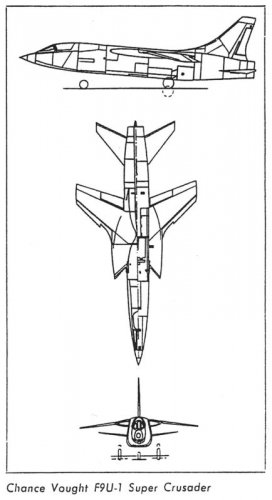overscan said:
A NASA photo of the XF8U-3 was published in A New Dimension; Wallops Island Flight Test Range: The First Fifteen Years by Joseph Shortal, in connection with the sonic boom tests there in July/August 1959. No idea if there's useful info in the book as I can't do the 230mb download until later this month.
http://ntrs.nasa.gov/archive/nasa/casi.ntrs.nasa.gov/19790011995_1979011995.pdf
Good Find:
Page 670 (!): In 1958, a program was initiated by H. H. Hubbard and D. J. Maglieri of the Dynamic Loads Division of Langley, to measure actual ground pressures accompanying sonic booms. Again, Wallops was selected for the tests because of its relative isolation. One measuring station was installed on the island proper, and two on the mainland between Wallops and Chesapeake Bay. The Langley Flight Division handled the flight operations, and Langley pilots were used in all the tests except one for a Convair B-58 flight in 1959.
The program at Wallops was conducted in two phases. In the first phase, between September 23, 1958, and October 9, 1958, six passes were made over the ground stations with a McDonnell F-101 airplane piloted by J. B. Whitten, and a single pass was made with a North American F-100 airplane piloted by J. P. Reeder. The passes were made at Mach numbers between 1.13 and 1.40 and at altitudes between 25,000 and 40,000 feet. In the second phase, between July 23, 1959, and August 6, 1959, two passes were made with a Convair B-58 airplane flown by an Air Force crew, and sixteen passes with a Chance Vought F8U-3 airplane with W. C. Alford as the pilot. In this phase, the passes were made at altitudes between 30,000 feet and 60,000 feet and at Mach numbers from 1.2 to 2.0.
Page 672: The interest in sonic booms was intensified with the proposal to build a supersonic transport to operate at Mach 3. It was possible to calculate a flight pattern from takeoff to landing, for which the overpressure at the ground would not exceed 1.5 pounds per square foot. Such a pattern involved a variable Mach number during the climb and descent phases. In order to obtain experimental data closer to the conditions than the data just discussed, the second series of flight tests at Wallops was made between June and August, 1959. These tests were made with the F8U-3 airplane at altitudes up to 60,008 feet and a Mach number of 2.0. In addition, to obtain data on the effect of airplane size, two passes were made with the B-58 airplane. In order to prevent further disturbance to the local communities, these passes were made over the ocean, parallel to the coast near Wallops. Instruments were placed both at Wallops and on two Navy ships stationed some 10 miles away.

